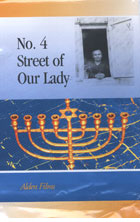
No. 4 Street of Our Lady 2009
Distributed by Alden Films, Box 449, Clarksburg, NJ 08510; 732.462.3522
Produced by Judy Maltz
Directed by Barbara Bird, Judy Maltz, Richie Sherman
DVD, color, 91 min., English and Hebrew, Polish, Ukrainian and Yiddish with English subtitles
Jr. High - Adult
Jewish Studies, World War II, History, Holocaust
Date Entered: 06/17/2010
Reviewed by Maureen Puffer-Rothenberg, Valdosta State University, Valdosta, GAIn 1941 Francisca Halamajowa and her daughter Helena lived at No. 4 Street of Our Lady in Sokol, Poland (now Sokol, Ukraine). When German soldiers occupied Sokol and began deporting and executing Jews, Halamajowa hid sixteen people from two Jewish families in a hayloft over a small brick building where she kept chickens and pigs. When Soviet troops liberated Sokol, the Maltz and Kindler families emerged after twenty months in hiding. Halamajowa then revealed a third Jewish family, the Krams, in a makeshift basement under her kitchen floor, and a German soldier hiding from Soviet troops in her attic. Halamajowa had singlehandedly saved half of the thirty Jews who survived World War II in Sokol.
Co-directed by Barbara Bird, Judy Maltz, and Richie Sherman, No. 4 Street of Our Lady is a powerful account of Halamajowa’s heroism, told through interviews, diary entries, archival photographs and documentary footage. The film focuses on Fay Letzter Malkin, Chaim Maltz and Eli Kindler, who ranged in age from four to six when they took refuge with their families in Halamajowa’s hayloft. In 2008 the filmmakers interviewed the three separately and together, reunited them with Yitte Maltz Nachfolger (the only adult survivor from the hayloft still living at that date), and followed the three (now living in the United States and Israel) along with Halamajowa’s granddaughters on a pilgrimage to Sokol.
There they visit Halamajowa’s home, the hayloft and basement, and the ruins of a nearby factory where hundreds of Jewish men including Malkin’s father were executed. Two of the few remaining Sokol residents still living recall the German occupation, Soviet liberation, and how Halamajowa’s neighbors suspected she was harboring Jews. Their memories are interwoven with excerpts from a diary Chaim Maltz’s father Moshe kept in the hayloft. Back in the U.S. Malkin and Maltz are reunited with Sam Kram, whose family survived the occupation in Halamajowa’s basement.
Survivors tell of life in the cramped hayloft, the struggle to keep silent (at one point the two families attempted to poison four-year-old Fay, whose constant crying endangered them all), and of the efforts Halamajowa and her daughter made to keep them informed and the children entertained. They also recall Halamajowa’s ingenuity and courage in keeping their secret: having lived in Germany and being able to speak German, she allowed neighbors to assume she was an anti-Semite, invented stories to explain her overuse of water and food, persuaded German soldiers to relocate a camp set up too near it, and hosted parties for Germans in her home.
Short onscreen titles describe historical benchmarks and brief comments from Dr. Amos Goldberg (The Hebrew University of Jerusalem), Irena Steinfeldt (Yad Veshem), and Professor Omar Bartov (Brown University) round out the historical information and highlight unique aspects of Halamajowa’s achievement in keeping so many people hidden for so long.
Halamajowa was forced to leave her home when the Soviets discovered the German defector in her attic; she spent the rest of her life in Raskzawa, Poland. As with many others who assisted Jews during the War, she declined to speak about her efforts, telling her grandchildren the Christmas packages they received from the Maltz and Kindler families came simply from “friends.” The film closes by telling what happened to the survivors and pointing to the ensuing generations of children and grandchildren who owe their lives to Halamajowa. The survivors marvel at her “incomprehensible” decision to risk her own life on their behalf; Kram says “She was a sucker for somebody in trouble ... she was an angel.”
The film conveys tension between the past and present, whether in survivor’s homes, on their journey to Sokol, or in the village. Home movies and archival photographs effectively breathe life into Halamajowa and older members of the Maltz and Kindler families.
This beautifully assembled and inspiring film is highly recommended where there is an interest in Jewish history or in the Holocaust. Awards:
- Rhode Island International Film Festival Grand Prize, Best Feature Documentary, 2009
- Accolade Competition Award of Excellence, 2009
- Mexico International Film Festival Silver Palm Award, 2009
- Athens International Film Festival 2nd Prize Winner, Best Feature Documentary, 2009
- CINE Golden Eagle Award, 2009
- Columbus International Film & Video Festival Honorable Mention, 2009